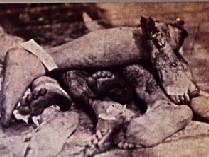|
Surgeons,
Tools, & Practice
|
|
Surgeons, & their practices:
During the period just before the Civil
War, a physician received very little training. Most of the older doctors
served as apprentices. Even the people who had attended medical school
were poorly trained. There were very few medical schools. Four-year medical
schools were common in Europe. Laboratory training was widespread, and
a greater understanding of disease and infection existed. In the U.S. the
average medical student trained for two years or less. They received practically
no clinical experience and were given no laboratory instruction. Harvard
University didn’t even own a stethoscope or microscope till after the war. |
|
| When the war began, 98 were the number
of medical officers the Federal army had. The Confederacy had only 24.13,000
Union doctors had served in the field and in the hospitals by 1865.In the
Confederacy an unknown number of volunteers and about 4,000 medical officers
treated war casualties, in both the North and the South these men were
assisted by thousands of women. In Union hospitals 4,000 is the estimated
amount of women who donated their time and energy to help the wounded.
Confederate women also served as nurses. |
| Civil War doctors were called “Butchers”
by the press and their patients. The doctors would have no mercy. Usually
the body part where the wound was located on a soldier was amputated (cut
off). Then the amputated limbs were tossed in a pile on the ground. In
48 months most doctors managed to treat more than 10 million cases of injury
and illness. In the four-year conflict 360,000 Northerners and 260,000
Southerners died. That is a total of 620,000 men that died. Of these numbers
about, 110,000 Union and 94,000 confederate men died of wounds received
in battle. Mortality from disease and wounds was far higher than from bullets. |
 |
|
| By modern standards during the Civil War, sanitary
conditions were shocking. Dorthea Dix was famous for her earlier work in
mental institutions. She served as superintendent of women nurses. |
|
| Private organizations helped care for ill and
wounded soldiers. The United States Sanitary Commission, created in June1861,
operated hospitals and distributed supplies. It cared for Southern and
Northern men. A similar organization, the Christian Commission provided
welfare assistance. The thousands of volunteer nurses included Clara Barton.
She later founded the American Red Cross. |
| Medicine: |
| Medicines were limited to standard remedies,
which are named opium, morphine, Dover’s powder, quinine, rhubarb, Rochelle
salts, castor oil, sugar of lead, tannin, sulphate of copper, sulphate
of zinc, camphor, tincture of opium, tincture of iron, tincture opii, camphorate,
syrup of squills, simple syrup, alcohol, whiskey, brandy, port wine, sherry
wine, etc. |
|
| Practically all the medicines were in powder
form or in the liquid state. Tablets had not yet come into use. Pills were
very far from being as plentiful as they are today. Most powders were stirred
in water and swallowed. The medicine was usually bitter. Asafetida, valerian
and opium and its derivatives were all about the Civil War surgeon had
to relieve nervousness and induce sleep. |
| Tools: |
| Among the supplies were chloroform, ether, brandy,
aromatic spirits of ammonia, bandages, adhesive plaster, needles, silk
thread for ligatures, etc. Amputating cases were supplied with catlins,
artery, forceps, bone forceps, scalpels, scissors, bullet probes, a tourniquet,
etc. While all the instruments were washed in water and wiped dry to keep
from rusting, such an idea of making them aseptic never entered the head
of the most advanced surgeon. |
|
| As you see the Civil War was just as hard on
the doctors and nurses as it was on the soldiers. ”Thank you, ” to the
doctors and nurses that took part in the Civil War. We’ve learned a lot
from you. We now know what to do and what not to do during a war. Technology
has advanced in many ways. |
|
| Thank you to everyone that participated in the
Civil War. Lincoln made it known that they didn’t die in vain. Everyone
fought for a purpose. Because of that purpose they will always be remembered.
They are apart of a history that will be taught throughout every generation.
Thanks for being apart of history. |
|
|
Bibliography
|
|
| "Civil War" The World Book Encyclopedia Field
Enterprises Corporation, Volume 4, 1973 |
|
| Source: The Civil War Society's "Encyclopedia
of the Civil war "Civil War Medical Care, Battle Wounds, and Disease" [http://www.civilwarhome.com/civilwarmedicine.htm]
(Nov.1,2000) |
|
| Source: Henry Steele Commagers's "The Blue
and The Gray," Volume II, Chapter XXII "Civil War Hospitals, Surgeons,
& Nurses" [http://www.civilwarhome.com/hospitalssurgeonsnurses.htm]
(Nov. 6, 2000) |
|
| "The Regimental Hospital" [http://www.civilwarhome.com/regimentalhospital.htm]
(Nov.6, 2000) |
|
| By: Elize
Ramos |
|
8th grade |
|
2000 |
